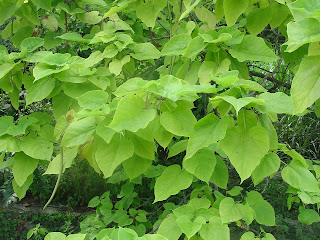.jpg) Northern catalpa or Indian cigar tree (Catalpa speciosa) has enormous presence in any landscape setting (USDA hardiness zones 4-8). Finding a 70 – 80 foot tree with a massive trunk and thick sinuous limbs is not unusual from Ohio south thru Tennessee.
Northern catalpa or Indian cigar tree (Catalpa speciosa) has enormous presence in any landscape setting (USDA hardiness zones 4-8). Finding a 70 – 80 foot tree with a massive trunk and thick sinuous limbs is not unusual from Ohio south thru Tennessee.
In summer its huge heart –shaped, pale green leaves may be easily reach 8 – 12 inches long and wide. Birds often seek shelter under its foliage cover. Catalpa offers a spectacular floral display lasting two weeks and more in May. The enormous coarse textured foliage offers some tropical appeal.
Numerous two- inch long white flowers are borne on large terminal spikes, many unfortunately hidden beneath the enormous catalpa leaves. Each flower has small gold spots within its frilly edged corolla. Narrow cylindrical cigar fruits, 8 – 15 inches in length are easily visible in the fall and winter months.
Catalpa trees are often visited by the catalpa sphinx moth whose larvae (caterpillars) are prized by fishermen for bait. Hummingbirds are a major pollinator, attracted to the floral nectar.
The tree is common along roadsides, particularly in bottomlands, often growing in poor soil. For most residential neighborhoods catalpa’s fast growth rate and enormous size make it of limited value. The brittleness of small limbs (twigs) requires almost constant clean-up around lawn areas.
Southern catalpa (C. bignonioides), another native form, grows smaller, averaging 35-50 feet in height (zones 5-9).

 Posted in
Posted in 
